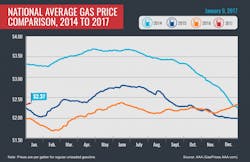National Gas Average Increases To Highest Price Since June, AAA Reports
The national average price of gas continues to increase, reaching today’s average of $2.37 per gallon, the most expensive average since June 2016. Gas prices have moved higher by three cents per gallon on the week and 17 cents per gallon on the month. Retail prices have increased for 40 of the past 42 days as a result of market reactions to the OPEC oil cut agreement. Traders and industry alike will keep a close eye on OPEC compliance as they await the release of the first output report which is expected in mid-February.
Quick Stats
- The nation’s top ten least expensive markets are: South Carolina ($2.14), Tennessee ($2.14), Mississippi ($2.15), Alabama ($2.16), Arizona ($2.16), Arkansas ($2.16), Texas ($2.17), Oklahoma ($2.17), Louisiana ($2.18) and Missouri ($2.18).
- The biggest weekly increases are seen in Michigan (+9 cents), Pennsylvania (+8 cents), Delaware (+8 cents), Oregon (+7 cents), West Virginia (+6 cents), Washington (+6 cents), Alaska (+6 cents), Ohio (+5 cents), Virginia (+5 cents) and Maryland (+5 cents).
West Coast
A number of refineries in California had challenges over the past week, including a power outage at Phillips 66’s Wilmington refinery last Thursday. The company’s Carson refinery has experienced reduced runs due to issues with the crude oil distillation unit’s heater that have been ongoing since November. Tesoro’s Los Angeles refinery is believed to be planning turnaround activity on a coker unit, hydrotreater and hydrocracker unit during January and February, while flaring activity was reported at Chevron’s Richmond facility, Phillips 66’s Rodeo plant and Shell’s Martinez refinery. OPIS also reports that Valero’s Benicia, California refinery is planning maintenance on a crude distillation unit heading into February.
Reduced gasoline production in the state has historically led to price spikes based on the region’s relative isolation from other markets. States in the region continue to post some of the nation’s highest averages at the pump: Hawaii ($3.03), California ($2.81), Alaska ($2.74), Washington ($2.73) and Oregon ($2.55).
South and Southeast
Drivers in the Southern region continue to pay some of the nation’s cheapest prices at the pump. South Carolina ($2.14), Mississippi ($2.15), Alabama ($2.16), Arkansas ($2.16), Texas ($2.17), Oklahoma ($2.17), and Louisiana ($2.18) are all listed on the top 10 list of cheapest markets in the country this week. Drivers have seen prices climb higher on the week in every state in the region except Kentucky and Florida. Although prices have moved up, the weekly increases were 3 cents or less in most states. The market remains well supplied with gasoline and prices are expected to continue to remain relatively low in comparison to other regions through the month.
Midwest
According to the latest EIA report, regional Midwest inventories remain abundant and production from regional refineries is also high, however, pump prices in the region remain volatile, with Michigan (+9 cents) and Ohio (+5 cents) seeing weekly increases while drivers in Indiana (-7 cents) and Illinois (< 1 cent) saw weekly declines. Monthly increases in Michigan (+34 cents), Wisconsin (+28 cents) Illinois (+27 cents), Ohio (+27 cents), Indiana (+26 cents) and Minnesota (+26 cents) rank in the nation’s top 10 largest increases and every state in the region is posting double-digit increases over this same time period.
Mid-Atlantic and Northeast
Retail averages steadily increased week-over-week in the Mid-Atlantic and Northeastern region, moving by a penny or more in most states. Pennsylvania ($2.65), Washington, D.C. ($2.58) and New York ($2.54) remain the only states with an average price above the $2.50 per gallon benchmark. Colonial Pipeline reported Sunday that they have shut down Line 19 near Chattanooga, Tennessee due to a suspected gasoline release. Line 19 delivers supply to Nashville, Tennessee, from Atlanta, Georgia, via Chattanooga, Tennessee. OPIS reports that an extended shutdown of Line 19 could potentially cause supply issues in the Tennessee region and could also mean a possible back up of supplies into the Gulf Coast.
